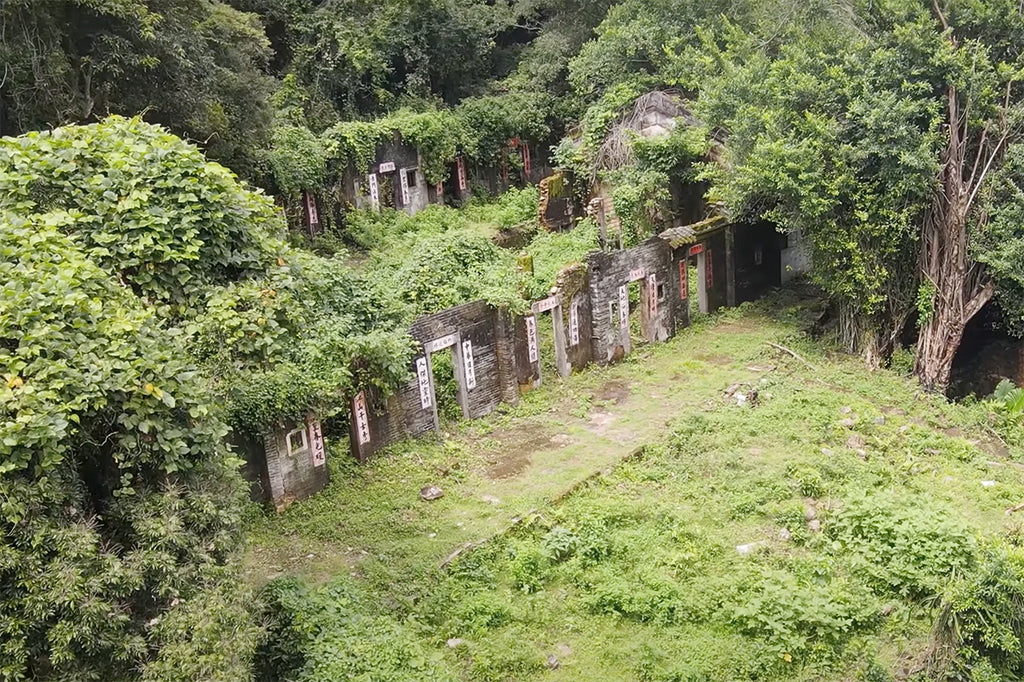So Lo Pun 鎖羅盤

"There are rumours that the inhabitants of this place disappeared overnight. I was alone on the day I visited. When I stepped in front of their homes, my head hurt but my heart hurt even more."
「有傳這個地方居民一夜消失,到訪當天我獨自一人,當我踏進它們的家門前,頭很痛,心更痛。」
There is a trend in society to gossip and be particularly excited about ghosts and spirits. It is sad when everything is packaged in such a way before anyone pays attention to it. The village of So Lo Pun is one of these sad rumours. Hong Kong is full of high-rises and yet the forested area in the northeast of the New Territories takes up a huge amount of land and many of the villages are deserted.
社會有一股風氣,就是喜愛討論八卦,對鬼怪靈異事特別雀躍,然而當所有東西都要包裝成這個角度才有人留意,那就十分可悲,而鎖羅盆村就是其一。別看香港高樓林立,在新界東北的林區佔地極大,當中不少荒廢鄉村。

So Lo Pun is located in the North District of the New Territories, near Lai Chi Wo, or to be more precise, behind these five areas, including Ah Kung Tsui, Kam Shan Tsui and Cheung Shek Tsui, part of the Sha Tau Kok Ten Covenants, the Hing Chun Covenant. The villagers are surnamed Wong, a branch of Lai Chi Wo Village. Because of its remote location and the fact that many people interpret So Lo Pun to mean a locked compass and hence it will not work in the village. There are rumours of getting lost but in my opinion, it is the once self-sufficient lives of the villagers that are worth exploring more than spirits.
鎖羅盆可說是絕處求生,位於新界北區近荔枝窩,再準確點是五咀之後,包括亞公咀、金山咀、長石咀等,屬沙頭角十約中「慶春約」,村民姓黃,是荔枝窩村分支出來。因為位置偏遠,加上不少人把「鎖羅盆」解讀成羅盤被鎖住,意指南針會在村中失靈,傳出種種迷路傳說,但在我看來,比起靈異事件,村民曾經自給自足的生活,才是真正值得還原探索的事。
There are many ways to get to So Lo Pun. For those who love long hikes, you can start from Wu Kau Tang, pass Lai Chi Wo to So Lo Pun and finish at Luk Keng. You can also walk from Luk Keng to Lai Chi Wo and take a boat. However, this service is only available on holidays. As the goal this time is to go to So Lo Pun only, we decided to take a shortcut via an old route. It was difficult to navigate. We knew the chances of getting lost were extremely high. From Luk Keng, the first 3km of the trail is along the coast through Ku Po Village, with picturesque scenery and plenty of places for refreshment and chat. It’s a great route for beginners or for a family. But I don't even have time to enjoy a bowl of signature tofu pudding. I hope that this journey, which is sweet and then bitter, will end with good memories.
前往鎖羅盆有很多方法,喜歡長征的朋友可以由烏蛟騰出發,經荔枝窩到鎖羅盆,最後以鹿頸作終。同時亦可由鹿頸出發,走到荔枝窩坐船走,但只限假日有船。由於今次的目標只有鎖羅盆,所以決定抄小路古道前往,但相當難行,迷路指數極高。由鹿頸出發,經谷埔村首3公里主要沿海而走的石屎路,風景如畫,還有許多補給閒聊地點,屬初階或親子路線,但我連吃一碗招牌豆腐花的時間都沒有,希望這躺先甜後苦的旅程,最後都可以以甜美的回憶作結吧。
When you arrive at Song Kee Store, continue ahead. Turn to the left to the stairway. Don't think it’s an easy road when you get there. At this point, you need an offline map. Turn left into the woods to officially embark on the Gu So ancient road. According to the map, it is a straight line from Ku Po to So Lo Pun via Tsim Kwong Tung Au, but the moment I took the first step, my feet were muddy. My head was covered in thorns. I knew I had miscalculated the area. The old road was used by the inhabitants to transport goods in and out in the past. I don't know if the road had been left untouched for too long as it had turned into a dense forest. The road was so slippery that one could accidentally step into deep mud which splattered over your face. This is not the worst part. It was frustrating when I accidentally took a wrong turn and had to clear the branches and thorns to find my way. I couldn't straighten my body, holding the phone in one hand for location and not knowing whether to protect the camera equipment or myself with the other. After the first km of the trail, there was a small stream at the bottom of Tsim Kong Tong Pass. I washed my hands immediately. The road up the hill is still full of gravel and easy to slip, but the main point is that there were lots of mosquitoes. Did the villagers in the past have antibodies that made them immune to mosquitoes?
到達松記士多後要轉進去,直走左手邊會有樓梯,上去後別以為還可以走康莊大道。這時要開啟離線地圖轉左走進叢林了,正式踏上谷鎖古道。根據地圖顯示,由谷埔經穿光峒坳到鎖羅盆是直線一條,但踏出第一步,腳踩泥濘,頭披荊棘那刻,我就知道自己完全錯判形勢了。網上消息指,這條古道是往日居民進出運貨的通道,不知是否因為太久沒人走了,完全變成密林。路面極為濕滑,一不小心就踩進不底深泥,突如其來蜘蛛網面膜都不算最可怕,一不小心走錯了一點點,要撥開樹枝尖棘找路,才是沮喪的,身體又伸不直,一隻手拿著電話定位,另一隻手不知要護著拍攝器材,還是保護自己。走過首1公里的路,尖光桐坳底有一條小溪,立刻洗一洗手。往後就清晰多了,但上山的路依然充滿砂石容易滑倒,重點是超級多蚊,到底以前的村民是不是有抗體對蚊蟲免疫了?
It took about an hour to get out of the woods. I thought my nightmare was over, but it was only the beginning. I was lost! I was supposed to keep to the left to get to So Lo Pun Village, but I deviated from the route and walked out of the swamp. The trees around me were taller than me. I couldn't tell where I was going, but along the way I smelled something like lemons. I immediately recalled the information I had gathered before setting out on my journey:
上山落出大概1個多小時走出叢林以為惡夢完結,怎料才是開始,我迷路了。原本應該是靠左邊一直走就到鎖羅盆村,但我偏離路線走出沼澤,周遭的樹比我還高,完全無法分辨方向,但沿路聞到很香的味道,像檸檬,我立刻想起出發前搜集資料提及:

"So Lo Pun is well endowed with natural resources supported by clear water from the valley with Kat O Bay in front. The village here is self-sufficient with terraced fishponds, sweet potatoes and vegetables. Most of the men go out fishing while the women farm and look after their children" and so on.
「鎖羅盆天然資源充足後有清澈谷水,前臨海產豐富的吉澳海灣,所以這裡的村屋自給自足,建梯田魚塘,會種蕃薯、蔬菜,男士大多出外捕魚 ,女士則耕田照顧子女....」等等
I believe I am in a rural area of the past or at least in the So Lo Pun area. I couldn't get the smell of lemons out of my mind but later realised it was verbena which repel mosquitoes. No wonder the villagers weren't afraid of these nasty pests. After my drone helped to locate my position, I finally entered the village, having heard many rumours and horror stories, but I didn't feel the least bit eerie. In the 1970s it was at its peak with over 170 people living here, but by the end of the 1970s villagers began to move out. By the 1980s the whole village was deserted. Although most of the roofs have collapsed, the couplets on the doors are intact and the remaining population who continued to stay here is not the result of nature but the perseverance of the village descendants over the years. It is rumoured that the inhabitants of So Lo Pun disappeared overnight, but in fact, they have prospered and left the village. They still remember their hometown, returning to the village every year on the first day of the year to put up couplets and clean the ancestral hall. The villagers express their hopes for the new year with auspicious words, adding life to these ancestral houses.
所以我相信我位處於往日的農地區,起碼已到鎖羅盆範圍。我對那種檸檬味念念不忘,後來才知道是馬鞭草,有提神驅蚊作用,怪不得村民不怕蚊。在航拍幫忙定位後,終於進入村,聽過很多恐佈傳說,但到後沒有絲毫陰森感。這裡在1970年代是全盛時期住了170多人,但到70年代末村民開始遷出 ,80年代更全村荒廢,現在雖然大部分屋頂已倒塌,但門上的對聯字體清晰,剩餘的人氣不是大自然的刻意眷顧,而是村民後代的多年堅持。外人流傳鎖羅盆的居民一夜消失,事實上後代繁衍,還對家鄉念念不忘,每年歲末一都回村貼對聯、打掃祠堂,以吉祥語表達村民對新一年的寄望,為祖屋添生機。
The couplets are very interesting. Besides being blessings, these are also inspirational quotations for life, showing the wisdom and insight of the villagers. My favourite line is "The cold snow ends when plum emerges; the spring breeze returns when willow appears.” As I continued to walk around the village, I saw a playground with metal frame facilities only found in old villages, the same of which I had only seen in Nam Shan Village, also over 30 years old. How can there be no school when there are traces of children's lives? There was once a school, the Kai Ming Primary School, built in 1932, which was said to have taken only students from Grade 1 to 3. It's a pity we couldn't find its exact location in the end. Imagine children running around the village after school. It won’t be quiet and dead as it is now!
對聯很有趣,除了祝福話,還有人生激勵名句,可見村民的智慧與見識。我最喜歡這句「寒雪梅中盡,春風柳上歸。」我繼續在村內走走,看見舊村才有的鐵架遊樂設施,同樣的我只在南山村看到,同樣有三十多年歷史。有小朋友生活的痕跡怎會沒有學校?這裏曾經有一間學校,名叫啟明小學,據說在1932年興建,只會收一至三年級學生,可惜最後找不到它的確實位置,試想像小孩下課後在村內跑來跑去,還會覺得這裡死氣沉沉嗎?
Since I am here, I don’t want to miss any corner. The buildings are terraced, and you can imagine neighbours back then were like family, a close relationship which has disappeared in modern Hong Kong. The underground concrete road is marked in English, for example, DOTP 1958. In 1958, the Kadoorie Agricultural Aid Association (KAAA) helped the Old District Office North (DOTP) in Tai Po to build this concrete road for villagers hence the abbreviation.
難得來到這裡不想錯過每個角落,發現建築是梯田式的,左鄰右里親如家人的生活,在現代香港已消失。跟著石屎路準備走出海傍,地下石屎路有一些英文一,例如地下就寫DOTP1958。話說在1958年,嘉道理農業輔導會協助大埔理文府,興建這條石屎路,方便村民進出,所以DOTP就是大埔理文府簡稱。

The dam at So Lo Pun village was built by the villagers to separate the sea water from the fishponds. Because of the lack of maintenance over time and the departure of villagers, sea water has flooded into the fishponds, creating a junction between salt and fresh water to form a mangrove forest. The view from here is spectacular. See the tall high-rises in the mainland and feel you have travelled back in time. It is both awe-inspiring and saddening to think that as the city develops, the things that used to be there are abandoned and don’t exist anymore. In the long run, we would be left, without identity or history. What we have left are just a cold exterior. Would we know who we are?
來到鎖羅盆村的堤壩,這是當年村民隔海水及魚塘而設的,因為日久失修,村民又離開了,所以海水湧入魚塘,造成咸淡水交界,而形成紅樹林。這裡景觀開揚,遠眺內地的高樓,有一種古代人穿越時空的感覺,既驚嘆又感概,當城市光鮮亮麗地發展後,以前的事與物就棄了,視為不存在呢?長遠下去,我們作為這個地方的人,沒有過去歷史的身份,剩下只有冰冷的驅殻,我們還知道自己是誰嗎?
We sat down and had a bite to eat here before leaving. After passing through Yung Shue Wan, we return to the Song Kee Store in Ku Po where we started the journey. Some people say we should keep the ruins a secret and not disclose the location. But in my opinion, people have abandoned them. If these places are not conserved or promoted, they would only disappear without trace into the wilderness over time. I suggest not to have a vested interest and simply enjoy the footprints of those who have gone before you. Also don’t be selfish and destroy the unique beauty of the ruins by moving or destroying anything when you visit them.
在這裡坐下去吃一點東西就要離開了。經過榕樹凹回到谷埔的松記士多,一切回到最初的起點。有人說要將廢墟保密,不要公開地點。但在我看來,是人們遺棄了它們,這些地方若不被保育推廣,只會隨著時間,與自野融合,最終無痕消失。不要做既得利益者,獨享前人留下的足跡,亦不要自私,到訪時千萬不要移動、破壞當中的一草一物,破壞了它獨特的美態。

Leave a comment